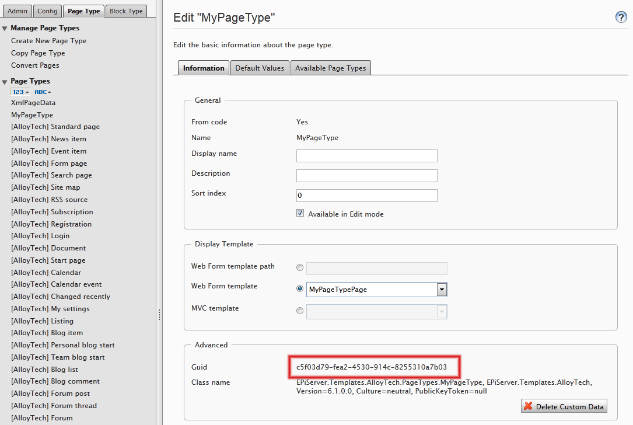A critical vulnerability was discovered in React Server Components (Next.js). Our systems remain protected but we advise to update packages to newest version. Learn More.
Refactoring content type classes
This topic explains how to work with refactoring, when you change, rename or delete content types in Episerver.
The following sections show various types of refactoring a content type class.
- Renaming a content type by GUID
- Renaming a content type by API
- Changing the content type for a property
- Deleting a content type class or property
- Deleting a culture-specific attribute from a property
Renaming a content type by GUID
When you rename a content type class, you create a new content type as long as you do not specify a GUID in the ContentTypeAttribute of the class. If there is no data in the previous content type, it is deleted. However, if there are pages created with the previous content type named, then the previous page type remains and the previously-existing pages use the previous content type. When you view the new content type in admin view under the Page Type or Block Type tab, the previous content type is marked as if it is missing its code.
If you specify a GUID in the ContentTypeAttribute and the GUID matches an existing content type, the content type is renamed and any previous data uses the renamed content type. The admin view displays the GUID of an existing content type when you edit the basic information for a content type.

Renaming a content type by API
When you rename a content type or property using the specific API, create a MigrationStep class with an AddChanges method where you specify the names of the content types or properties, to ensure that the existing properties are renamed, and retain values they had before they were renamed. The API is based on strings to know the names of previous types and properties.
Note: You do not need to manually register the MigrationStep class, since it will be automatically detected.
The following example shows how to rename both a content type and a property on that content type:
using EPiServer.DataAbstraction.Migration;
namespace CodeSamples
{
public class MigrationStepExample : MigrationStep
{
public override void AddChanges()
{
RenameContentType();
RenameProperty();
}
private void RenameContentType()
{
//The content type formerly known as "Velocipede" should hereby be known as "Bicycle".
ContentType("Bicycle")
.UsedToBeNamed("Velocipede");
}
private void RenameProperty()
{
ContentType("Bicycle") //On the content type "Bicycle"
.Property("PneumaticTire") //There is a property called "PneumaticTire"
.UsedToBeNamed("WoodenTire"); //That used to be called "WoodenTire"
}
}
}Changing the type for a property
The following criteria are prerequisites before you can change the type of a property. The prerequisites ensure that a change of type in the code does not lose data.
- You must be able to set the previous value to the new type OR you can parse it in the ParseToSelf method of the new types backing PropertyData.
- The value of the backing PropertyData you are changing to must implement the System.IConvertible interface.
- The backing PropertyData also must have its Type property set to any of the seven first values of the PropertyDataType Enumeration.
- The previous or new property type cannot be a block.
- If the new type is String, then any previous value cannot be longer than 255 characters.
If the conversion of existing data to the new type fails, an error is logged and nothing is committed.
If you need a change of type and any data loss is acceptable, you can change the type of the property in admin mode, but you must temporarily remove the property from the code.
Deleting a content type class or property
When you delete a content type or property from the code, the system synchronizes the database as much as possible without deleting data (values saved on any page). If there is no data, the content type or property is deleted from the database. If any data is present, the content type or property remains and is marked in admin view as if it is missing its code.
Deleting a culture-specific attribute on a property
When you manually change a property in admin view from being culture-specific to not being culture-specific, the change may not be reflected on the site when there is culture-specific data stored in the database. If this occurs, an error is logged but makes no change to the property in the database.
Last updated: Jan 21, 2016
